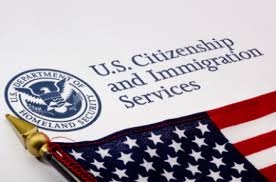POSTING DATE: May 20, 2019
Learn More About:
Immigration News & Updates eNewsletter © 2011 - 2019
For questions about U.S. Residency, Green Cards and Immigration Visas, Visit our Website at: www.ImmigrateToday.com or call our office at: (954) 382-5378
Check Out This Cool Stuff For Immigrants....
Immigration
Questions & Answers
This Week's Immigration News
Question: I am currently in the US and my mother who is a US Citizen and sister who is a Legal Permanent Resident would like to begin the application process of sponsoring me to become a LPR. I am currently married and would like to change my civil status. What is the procedure for applying for immigration, what documents will I need, how does changing my civil status affect my application, how long is the wait period?
Answer: First, you must understand that you are NOT allowed to stay and live in the U.S. under any circumstances during the time your immigration case is pending, unless you are in the U.S. on another legal visa like student F-1 or H-1B work visa, etc.
Only U.S. Citizens can sponsor adult children and siblings, so your sister is not eligible to sponsor you. Married adult children are in an immigration category called F3 which has a waiting line of about 12+ years. Single adult children are in an immigration category called F1, which has a waiting line of about 7 years. Once you divorce, you would be in the F1 line and would need to wait for 7 years or so before you will be able to immigrate. You should divorce in your home country, not here in the U.S., since in many states like Florida, you would need to reside here for at least 6 months prior to being eligible to file for divorce. That would violate your tourist visa.
The procedure for your mom to apply for you is for her to file a family petition on your behalf. She can sponsor you now to get you a place in line in the F3 category, then once you divorce, you will move up to the F1 category. She will need to provide a copy of your Birth Certificate and other information. Let us know if you would like us to take care of filing your immigration case for you.
Helpful Immigration Tips You Can Use...
Immigration News & Updates eNewsletter
eNewsletter
As expected, Trump rolled out the administration’s Immigration Plan last week in a speech at the white house, which if implemented, would forever change the character of a country which has for so long been known as a nation of immigrants. The plan intends to eliminate all family based immigration sponsorship (which Trump calls “chain migration”) with the exception of spouses and children and instead replace the existing immigration system with a merit based points program.
Under the new system, eligibility will be primarily based on education, skills, English proficiency and age, giving preference to young, educated, English speaking immigrants who have a well-paying job offer from a U.S. company.
Trump Releases New Immigration Plan
Drastically Slashing Family Sponsorship
Getting A Green Card Through Employment –Overview of the Labor Certification Process
Most Immigrants know that they can obtain U.S. Residency (a green card ) through family sponsorship, but the process to get a green card through a U.S. employer often remains a mystery. For instance, do you have to already be working for the company in order for them to sponsor you? Do you have to be in the U.S. to get sponsored? How long does the process take? How do you qualify? All very important questions.
For background, immigration regulations allow U.S. employers to sponsor foreign immigrants to immigrate to the U.S. in order to take up an available job position, which the employer has been unable to find a U.S. worker to fill.
USCIS Completes H-1B Visa Selection Process
And Will Begin Returning Those Not Selected Soon
Understanding the Real Consequences For Overstaying A U.S. Visa
With illegal immigration and the border wall in the news almost daily, it’s easy to overlook the fact that the majority of immigrants inside the U.S. who lack immigration status actually came here legally on a visa and simply overstayed. But of course you never hear about that because Trump doesn’t care about facts when it comes to immigration. According to Department of Homeland Security (DHS) statistics, of the approximate 53 million foreign visitors who legally entered the U.S. in 2017, more than 600,000, overstayed their visas by the end of that year. This is similar to years past and likely to current numbers, which will be reported by the DHS next year.
The USCIS announced last week that it has completed the H-1B work visa selection process for this year’s H-1B visa applications and will soon begin returning all H-1B applications, which were not selected.
Due to the high volume of applications, the USCIS has not provided a definite time frame for returning unselected petitions. From experience, I would guess that most unselected applications will be returned to petitioners by the end of May or early June if not earlier.
Read USCIS announcement
Immigration How To:
How Do I Know What Will Happen If I Overstay My Visa?
These days it’s getting more and more common to hear about U.S. Residents who have lived in the U.S. for nearly all their lives being deported because of some stupid criminal incident that happened when they were younger. Under previous administrations, Residents (green card holders) who broke the law had a chance to make amends and still stay in the U.S. through cancellation of removal or other means.
But under Trump immigration policies, more Residents than ever are being deported, including those with old criminal convictions who had previously received cancellation of removal issued by a federal immigration judge.
Naturalization – The Ultimate Protection Against Deportation!
But those who seek to base future immigration on merit, miss the whole point of America. The great strength of our nation is not that its immigrants have been especially extraordinary talented or professionally skilled, but that they are instead brave pioneers from around world yearning to be the best they can be, seeking a land like the United States, which allows individuals to strive and reach their full potential, for the benefit of all Americans. That is what makes us great! Sure, it is nice to have hi-tech immigrant entrepreneurs build mega companies and invent electric cars, but the secret ingredient of America is the rich cultural heritage and varied experiences that immigrants bring to our shores, which combines with our existing culture and enhances every aspect of our lives. This is our strength and that which sets us apart of many nations around the world.
Trump touts his Immigration proposal as enabling the U.S. to recruit "top talent" from around the world by eliminating the yearly visa lottery and most family migration and instead creating a new "Build America Visa" program which will recognize three main categories: extraordinary talent, professional, specialized vocations, and exceptional students. For background, under our current immigration system, approximately 12 % of immigrants are employment and skills based and some 66 % from family sponsorship, with more than 6 in 10 green cards granted based on family ties. Trump’s new plan seeks to increase employment and skills based immigration to 57 % and slash family immigration by half down to 33 %.
Given all its “hype”, the measure is short on any details and clearly lacking protections for Dreamers and any amnesty for millions of undocumented immigrants currently in the U.S. Under the current political climate it’s not clear whether any immigration measure could be passed by Congress, but given the constant, relentless calls from Republicans to terminate family immigration, it would be a very wise idea for U.S. Citizens and U.S. Residents (green card holders) to sponsor their loved ones, including adult children and siblings now, since these are the most vulnerable immigration categories likely to be eliminated in any bi-partisan immigration deal negotiated between the Democrats, Republicans and White House.
During his speech, Trump appeared to insinuate that some 4 million family and employment-based immigrants who have been waiting lines for so many years would lose their place in line under the new plan and need to apply under the new merit, points-based system. However, I believe that kind of retroactive rule would be impossible to enforce and the Federal Courts would block any move by the Trump administration to strip families of immigration benefits they have already legally applied for. Stay tuned….
So increasingly, even those with Green Cards no longer feel safe. That is why it is so important for Residents who qualify to take advantage of the ultimate safeguard to living the American dream – Naturalization. Becoming a U.S. Citizen with all its benefits and protections is the best way to safeguard your life and liberty in the U.S.. U.S. Citizens cannot be deported for any reason, unless they lied on their Naturalization application. For many, the only reason for delay is the high cost of the USCIS filing fee of $725. But the benefits far outweigh the sacrifice of cutting back on other expenses to save the necessary fees. Give it as a gift to yourself or to others!
Here’s a few of the main benefits of becoming a U.S. Citizen: No risk of Deportation from the U.S.. Even though Residents have legal status in the U.S., they can still be deported in certain circumstances. Even one serious criminal incident by a Resident who has never done anything wrong in the past, however unintentional, can result in removal from the U.S.. U.S. citizens who are convicted of any crime, no matter how serious, cannot be deported. Remember, no one ever thinks they will be convicted of a crime, until they are.
Benefits of a U.S. Passport. Residents may still need to obtain a visa to visit many countries around the world. However, U.S. citizens can travel to a majority of foreign countries without the need for a visa and receive easier entry through foreign borders as well. Another benefit for parents with minor children under age 18 is the ability of your children to automatically naturalize and become U.S. Citizens at the same time and you.
Ability to vote, obtain federal jobs, government benefits and even run for Public Office. Only U.S. Citizens are allowed to vote and even Naturalized U.S. citizens can run for most elected public offices (except the presidency). Similarly, certain federal jobs require U.S. Citizenship and certain benefits are only available to U.S. Citizens.
Ability to sponsor more Family Members. Becoming a U.S. Citizen allows you to sponsor your parents, married children and siblings. Similarly, immigration waiting lines are eliminated for spouses and minor children.
Ability to take long trips outside the U.S. Residents must be very careful about the amount of time they spend abroad and are often fearful of staying outside the U.S. for too long a time. Those who remain outside the U.S. for 180 to 364 days can be challenged by immigration officials about whether or not they reside in the U.S.. Those who remain outside for 365 days or more risk losing their Green Card. U.S. Citizens, however, can remain outside the U.S. indefinitely and still retain all the benefits of citizenship.
With all these benefits, it simply does not make sense to delay filing for Naturalization. Family members looking for a great Birthday, Anniversary or Christmas Gift should consider paying the $725 USCIS filing fee for a loved one to apply for Naturalization! That’s a gift that keeps giving and lasts for a lifetime, how many other gifts can you say that about?
Question: My son was born earlier than expected during a family visit to the U.S. some 20 years ago, so he got his U.S. passport. Now he is turning 21 later this year and we are planning that he will sponsor myself and my husband to immigrate to America as soon as possible. My son’s father and I are divorced since several years ago and last year I married my current husband. My husband thinks my son cannot sponsor him but I think since we got married while he was a minor under age 21 he can. So my question for you is whether my son can sponsor me and my husband together and how long it will take for us to be able to move to the U.S.? Also, my son currently lives here in the Bahamas but plans to move to florida in february of next year when his job transfers him to its miami facility. Can he sponsor us in november when he turns 21 if he is still living in Bahamas or does he have to wait until he moves up there to the U.S. next year? Thank you for your nice column we read it every week.
Answer: This is a very common question and often very confusing to parents of U.S. Citizens. Parents of U.S. Citizens are called “Immediate Relatives” (as are Spouses and Minor children).U.S. Immigration regulations only allow U.S. Citizens to sponsor each of their Immediate Relatives separately and no dependent spouses or minor children are able to immigrate along with them. For instance a U.S. Citizen child cannot sponsor his Parents together as a couple, instead, each parent must be sponsored separately in a separate family petition. Step-parents are considered to qualify as “parents” for immigration purposes, as long as the step-parent relationship was established before the child (U.S. citizen) reached the age of 18 (not 21). Therefore, your son can sponsor you and you can immigrate to the U.S. in about a year. However, your husband does not qualify as a step-parent since you did not marry before your son was age 18, therefore your son cannot sponsor him. Once you obtain your green card, you can immediately sponsor your husband and it will take about two years for him to be able to immigrate to the U.S.. Your son can file to sponsor you as soon as he turns age 21 in November, but he should have a U.S. address to use for your family petition. I hope this is helpful.
Question: My mother sponsored me and my family for our immigration papers and we just had the interview at the embassy last week and I already received the sealed package and paid the $220 fees per family member online. I saw where you said we need to printout the receipt and we did that. My question is about travelling. My husband and I have two daughters and one is still in school. I want to come up now with my youngest daughter and my husband will stay back and wait for my oldest daughter to finish school next month. Can we do that or do we need to all come at the same time?
Answer: That a great question. Family members immigrating together only get one immigrant visa package. Therefore, you all need to come together. Once you arrive at the U.S. airport, the immigration officer will open the package and verify the documents for the family, then stamp your passports with residency. After arriving, you will receive your green cards at the address you provide the officer within about 30-60 days. After you enter the U.S. and get your residency stamps, your husband and eldest daughter can then return home to allow her to finish up her school, then they can return to the U.S. using the residency stamps in their passports as evidence of U.S. Residency. Good luck!
Occupations which are often difficult to find qualified U.S. workers to fill cover the spectrum, from sheepherders (yes that is a real occupation) and tree cutters, to nurses, engineers and everything in between. Some occupations are more favorable for getting approved than others, depending upon the current job market and type of skills needed. For instance, low level positions which involve heavy labor or harsh conditions (often not requiring training or experience) such as for tree cutters working outside in the heat all day are very difficult to fill and are good prospects for labor certification approvals. Similarly, highly skilled jobs involving science, technology, engineering and math, requiring Bachelors and often Master’s degrees are likewise good candidates for approvals.
So how does the process work? First, it’s important to understand that the labor certification process to obtain residency through an employer does not in itself confer any legal immigration status or visa until the process is complete, so immigrants who are in the U.S. visiting cannot legally remain here during the process, unless they have legal status through another type of visa, i.e., H-1B work visa, F-1 student visa, etc. Sounds confusing, but it really does make sense, when you look at a typical labor certification case:
Yum Yum Chinese restaurant (Yum Yum) serves specialty Chinese cuisine. The restaurant is expanding and wants to open another location, but they have been unsuccessful in finding a qualified Chinese cook. The restaurant decides it must recruit and hire a cook from Hong Kong. Mr Wu who lives in Hong Kong has 15 years of experience as a specialty cook, sees an ad Yum Yum put in the Chinese newspaper looking for an experienced cook. Through an immigration attorney, Yum Yum begins the labor certification process, which first requires applying to the department of labor (DOL) to find out the minimum wage they are required to pay the cook, then proceeds with placing more ads to try to recruit a qualified U.S. worker cook and after no success, filing a labor certification application with the DOL requesting to permanently hire Mr. Wu for his green card.
After about four to five months, the DOL approves the labor certification application and in the next step, the immigration attorney files an employment Immigrant Visa application (called I-140) with the USCIS attaching the labor certification approval and other documentation, requesting approval of the visa. Thanks to expedited processing, the application is approved by the USCIS in as little as 15 days. Once approved, the USCIS sends the case to the National Visa Center to prepare the case form Mr. Wu’s appointment at the U.S. Consulate in Hong Kong. Approximately four months later Mr. Wu attends his consular appointment, receives his Immigrant Visa and comes to Miami a month later. Once he enters the U.S., immigration officers order his Green card and ask him what address he wants it sent to. Mr. Wu is now a U.S. Resident!
But what happens if Mr. Wu is already in the U.S. legally? Let’s say that Mr. Wu is here in the U.S. on an F-1 student visa attending courses at a cooking school. The process is exactly the same as above, except, once the I-140 Immigrant Visa application is approved by the USCIS in 15 days, Mr. Wu can immediately file his residency application to adjust status from a student visa to a Green card holder and he does not need to leave the U.S. and attend an interview at the consulate. Instead, after 6-8 months, he will attend his residency interview in Miami and receive his Green card in the mail within about 15 days.
This is the basic process in a nutshell. The only difference is in the timing for nationals of certain countries that have waiting lines for employment visas, so some immigrants have to wait longer than others. But for immigrants of most countries (except China, India and the Philippines), there are currently no waiting lines for employment green cards.
So how does an immigrant get sponsored by a U.S. employer? Well, that is the key, finding an employer in the U.S. willing to go through the above immigration process. It’s also important to note that for immigrants who are in the U.S. already working for an employer, but are out of legal status, immigration rules generally do not allow them to get a green card, except under certain limited exceptions.
You can find out more about the labor certification process by calling our office at: 954-382-5378
The top fifteen countries with the most overstays includes: Brazil, Canada, China, Colombia, Dominican Republic, France, Germany, India, Jamaica, Mexico, Nigeria, Philippines, Spain, U.K., Venezuela. So clearly, according to statistics by his own government agencies, Trump’s obsession with the wall and focusing on immigrants from Mexico and other Latin American countries coming in through our southern border is absurd. No doubt because Trump would rather hear his supporters chanting “build the wall”, rather than “stop those tourists”. In order to curb the number of visa overstays, the DHS has stepped up its efforts in the past several years by more extensive screening at airports and ports of entry, which includes searching electronic devices and social media to confirm the purpose of an individual’s visit to the U.S., calling family members and others listed as contacts by the visitor and even sending follow up email reminders that the period of stay will soon expire. These days, it’s not unusual for visitors to receive much less than six months authorized periods of stay, with some as little as several weeks.
Do what happens when an individual overstays a visa? Well, there are different consequences for those who overstay and remain in the U.S., than for those that overstay and then later leave the U.S.. Of course the best option is always to avoid overstaying a visa at all costs. For visitors, this usually means making sure to double-check the I-94 printout on the Customs and Border Patrol website to be certain to leave the U.S. before the stay expires and to avoid filing any immigration application to extend or change status in the U.S.. Such applications usually take up to six months to process, going past the applicant’s “authorized period of stay” and when denied, leave the individual with no options. Under the new NTA policy, when an application to extend or change status is denied, the USCIS now initiates deportation proceedings against the applicant. Those legally in the U.S. on work and investment type visas should file for renewal six months in advance and use premium processing when available, so that they remain in legal status during the renewal process. This keeps options open in case a renewal is denied, allowing the individual to perhaps file another type applications to stay in legal status.
Individuals who overstay a visa by even one day, automatically lose visa status (called “Visa Voidance”) and once they leave the U.S., cannot re-enter without reapplying for a new visa at the U.S. Consulate abroad. And of course obtaining a new U.S. visa after an overstay is a very difficult, if not impossible task, which can lead to successive visa denial for many years.
Those who overstay and then remain in the U.S. for a period of time before leaving face much tougher consequences and are barred from returning to U.S. for 3-10 years, depending on the period they overstayed. Here’s a rundown:
• 3-year bar: When an individual overstays in the U.S. for six months or more, once they leave they are barred from reentering the U.S. for three years from their date of departure.
3-year bar: When an individual overstays in the U.S. for six months or more, once they leave they are barred from reentering the U.S. for three years from their date of departure.
• 10-year bar: When an individual overstays in the U.S. for one year or more, once they leave they are barred from reentering the U.S. for ten years from their date of departure.
10-year bar: When an individual overstays in the U.S. for one year or more, once they leave they are barred from reentering the U.S. for ten years from their date of departure.
• Bar to Change of Status/Extension of Stay: When an individual overstays in the U.S., even by one day after their authorized period of stay, they become ineligible to extend their stay in the U.S. or change their status to another nonimmigrant status. The only immigration option is obtaining residency through a real marriage to a U.S. Citizen.
Bar to Change of Status/Extension of Stay: When an individual overstays in the U.S., even by one day after their authorized period of stay, they become ineligible to extend their stay in the U.S. or change their status to another nonimmigrant status. The only immigration option is obtaining residency through a real marriage to a U.S. Citizen.
Clearly, overstaying a U.S. visa has unwelcome consequences which take effect immediately upon the first day of overstay, so the best way to avoid that is to preplan your immigration options far in advance of your visa expiration.












